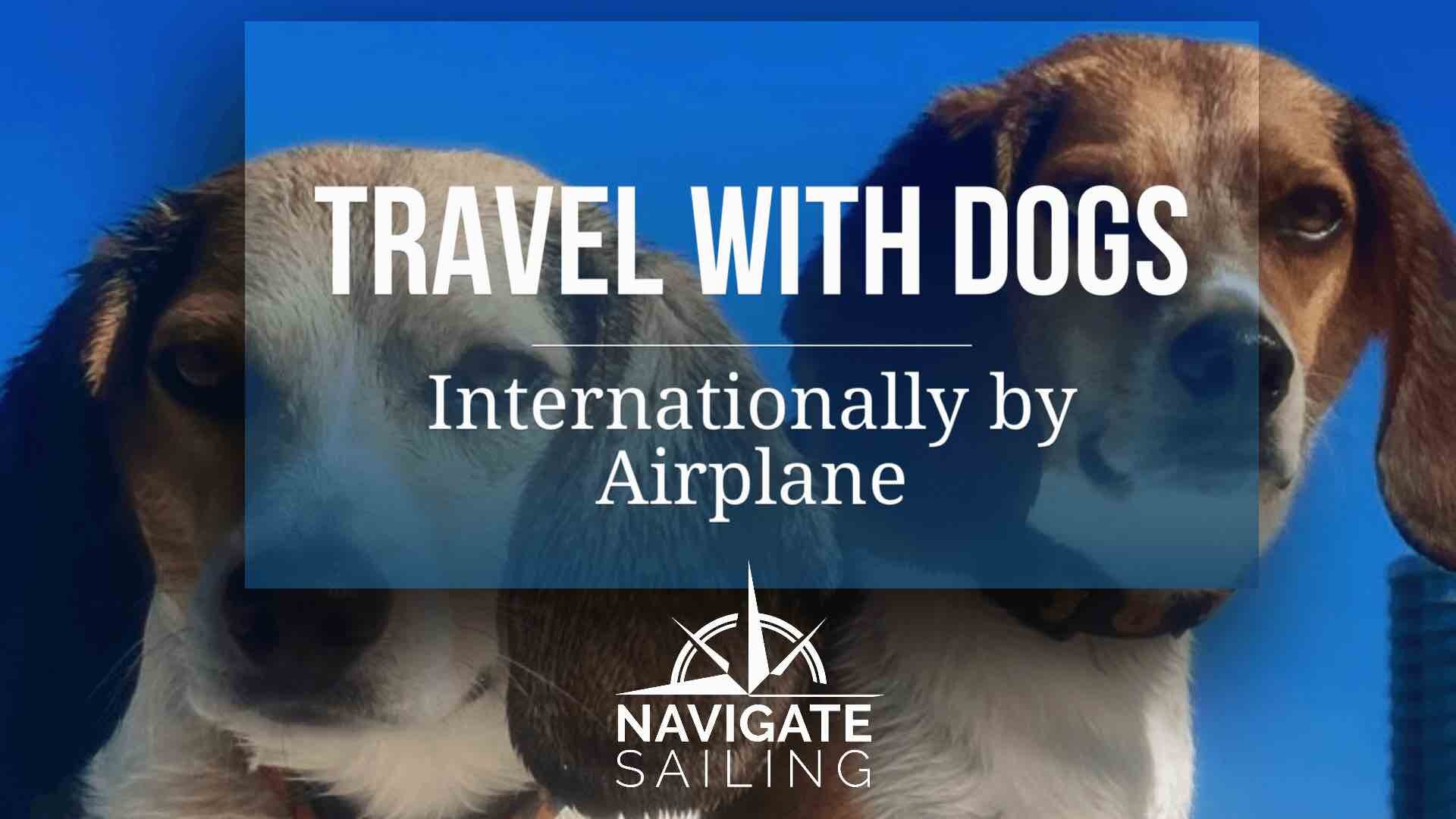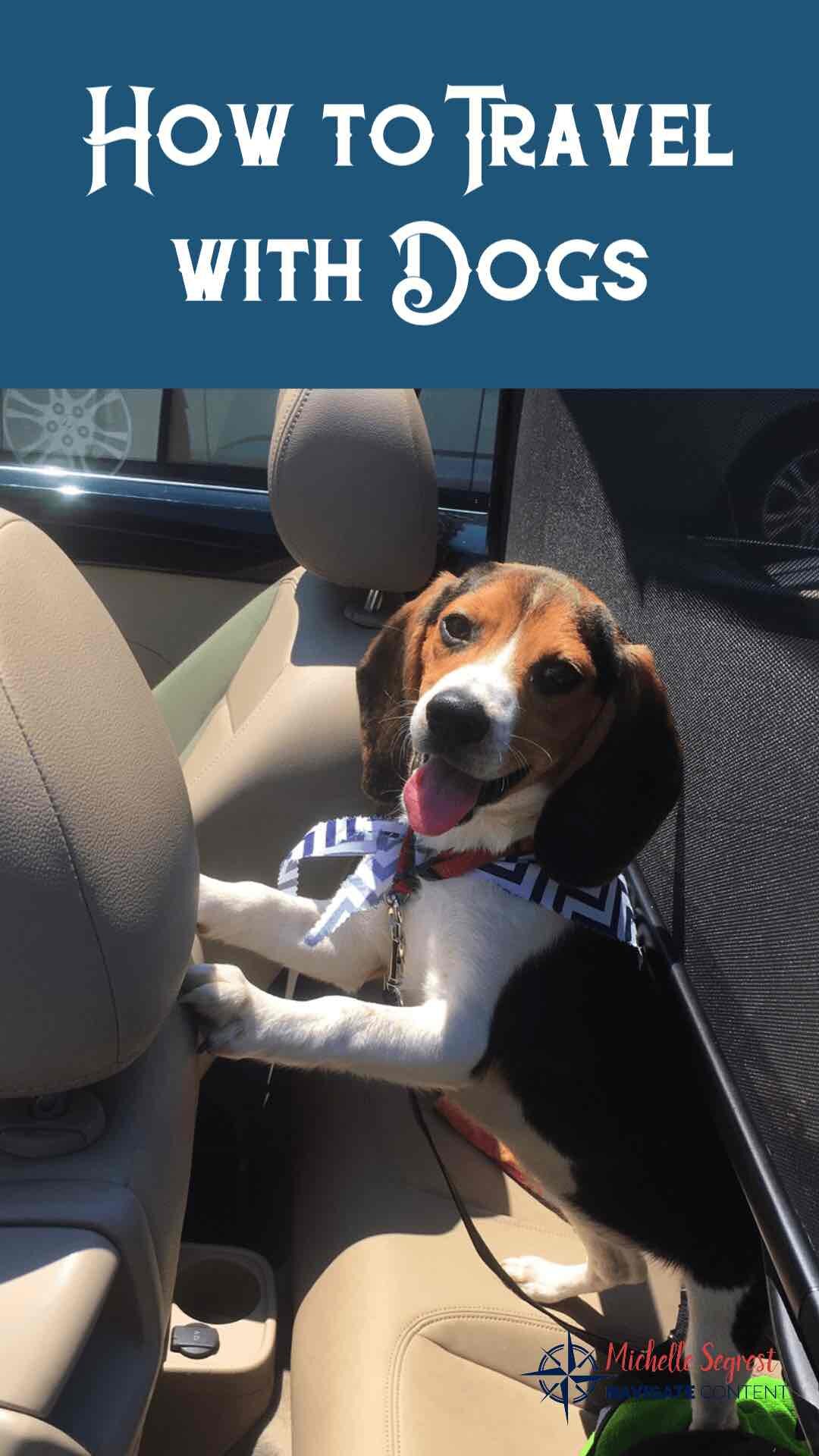14 Tips for Traveling Internationally With a Dog on an Airplane
/Learn expert tips about traveling with a dog on an airplane internationally, the products you need, and how to navigate the airline requirements for traveling with dogs.
By Michelle Segrest — How to Get Your Sea Legs
The challenge of traveling across the Atlantic with dogs by sea was easy when compared with the challenge and stress of putting them an airplane and transporting them internationally.
A cross-Atlantic voyage had been in the works for several years—intensely for more than a year. In May 2018, the decision was made to take our two beagles—Cap’n Jack and Scout—with us on our year-long worldwide sailing voyage. This was about three months before we set sail. We just couldn’t imagine not being with them during the time it would take to sail from North Germany to South Alabama. There was a lot of work to do in a short amount of time.
While also planning what it would take to have them on board a 43-foot sailing yacht at sea, a journey across the Atlantic with them by air needed to be carefully planned. I originally thought we could just call an airline and book a couple of puppy tickets. Easy, right? People do it all the time.
That bubble was burst very quickly.
Based on months of research and many lessons learned, here are some tips:
14 TIPS for TRAVELING INTERNATIONALLY WITH DOGS ON AN AIRPLANE
Research and plan early—at least two months before the flight.
Locate an IPATA-approved pet carrier if flying from or to the U.S.
Order the pre-approved airline safety travel crates and other supplies early.
Help your dog adapt to the crate well in advance of the flight.
Work closely with your veterinarian to get all shots and necessary paperwork taken care of early.
Create and invest in a first-aid kit for your pet.
Carefully research the regulations of your departure and arrival countries.
Be prepared for long customs procedures at the sites of departure and arrival.
Book a direct flight, if possible.
Avoid giving your dog a sedative for the flight. Our veterinarian strongly urged us to resist this temptation as it could cause other medical issues for your pet.
Visit a local veterinarian at the arrival country to secure a European Pet Passport and other required documents.
Have plenty of water and extra food available for the flight.
Pack your pet’s favorite blanket and toys in the travel crate.
Give your dog a chance to run and play unleashed upon arrival.
If traveling by car with your dog and family, here are some tips.
Finding the Perfect Pet Carrier for Traveling on an Airplane with a Dog
Airlines don’t let you just book a ticket for your pet online or by phone anymore—at least not from the U.S. to Europe. Trust me. I called all of them. I learned quickly that for a dog to travel overseas on any airline, you must employ the services of an IPATA-approved pet carrier service. IPATA stands for the International Pet and Transportation Association. Working with them is now a requirement for ALL airlines flying internationally from the U.S.
There are many capable carriers. Trying to be thorough, I interviewed five of them. The prices were similar, so I decided to go with a pet carrier that was local to Atlanta, Georgia, which is where we would make our departure. We found a fantastic one—Pet Air Carrier, of Alpharetta, Georgia.
Finding the Perfect Airline-Approved Crate for Traveling on an Airplane with a Dog
I found a direct flight from Atlanta, Georgia, USA to Frankfurt, Germany that was nine hours long. The professionals at Pet Air Carrier helped us with every detail. They secured all the appropriate paperwork and even helped us correctly measure the size of our airline-approved pet carriers. You can learn more about what I think is the perfect safe dog crates for airline travel.
Pet Air Carrier gave us the logical advice to order the crates early, put them in our apartment, and help the beagles to get comfortable with them many weeks before time for the flight. It’s not a good idea to wait until the day of the flight to have the dogs go into the crates for the first time. This could add to their anxiety of the air travel, so it is highly recommended to get them acquainted with the crates weeks before the flight.
Because of the size of our dogs, we used an airline-approved cargo crate from PetMate.
Some smaller dogs may be able to fly with you in the cabin, but you still need an airline-approved travel carrier.
Requirements to Travel Internationally by Airline for U.S.-Based Dogs
To travel by airline with U.S.-based dogs (and to enter most countries), the dogs must have these three things:
USDA-stamped health certificate. This must be approved by a licensed veterinarian, then shipped to the state’s health department for signature and seal. This must happen within 10 days of the flight. For us, we had to ship overnight to Montgomery, Alabama and have it returned to us before we left for our flight to Frankfurt.
International microchip
Rabies vaccination AFTER the microchip has been implanted
Some countries also require:
Rabies titer
Flea and tick treatment
Heartworm treatment
De-worming treatment
Check out our eBook, How to Sail with Dogs—100 Tips for a Pet-Friendly Voyage for all of our research of the requirements for each country we visited and/or planned to visit during our sailing voyage. You can find more updated information and information about other countries not listed here by referencing these helpful websites: BringFido, Noon Site, and Pet Travel and by researching the individual country’s tourism website.
I worked closely with our regular veterinarian, Dr. Niesje Langston, in Gulf Shores, Alabama, to secure the proper USDA-stamped health certificate, microchip, rabies vaccination, rabies titer, flea and tick treatment, heartworm treatment, and all the other appropriate pup requirements. She also helped me create the perfect doggie first-aid kit.
Pet Air Carrier met the beagles and me at the airport in Atlanta and made sure the pups were checked in and secured correctly. They also arranged to have a pet customs broker help us out when we arrived in Frankfurt to handle all the customs paperwork on that end. We were much more nervous about transporting the seadogs by air than by sea, although the sea details are also long and laborious.
How to Get a European Pet Passport for Traveling Internationally with a Dog
We used Lufthansa as our airline. They have a pet lounge and a lot of experience transporting animals of all kinds. They are famous for making safe and comfortable transports for canine family members. We made an early appointment with a veterinarian in Nidderau, Germany so we could easily get the appropriate European shots and European Pet Passports (European Pet Passport) for Cap’n Jack and Scout. The passport became our major document for checking them in and out of most countries, including some countries outside the European Union.
For more information on the how and why of European Pet Passports, consider reading this post: How and Why to Get an EU Pet Passport.
All of this planning and preparation requires hours and hours of work. Some countries, like Barbados and The Bahamas, have extraordinarily strict entry requirements for pets and require pre-approved import permits. We decided to enlist the help of customs brokers for those two destinations, even though we re-routed to Brazil from Cape Verde and actually have not gone to either of those destinations yet.
We also learned that it is impossible to take a U.S. dog into the United Kingdom on a private vessel, so we re-routed our journey to avoid the U.K. altogether. There are some other countries that prohibit dog entry if the host country is the United States.
Flying with the Dogs to Frankfurt, Germany
We chose the flight from Atlanta to Frankfurt for a few strategic reasons. First, Atlanta has the largest international airport that is close to our home in Gulf Shores, Alabama. We needed to fly the beagles to Germany because this is where our sailing vessel, Seefalke, was moored (in Stralsund, which is in the northeastern region of the country). It was important to us to have a direct flight so we would not have to worry about the extra hassle of a layover.
Also, we have a relative who lives close to Frankfurt (in Nidderau), so we could make arrangements to stay with her one or two nights before taking the eight-hour train journey to Stralsund. Furthermore, we could make an appointment with a local veterinarian in Nidderau to secure the European Pet Passport.
The beagles and I left Gulf Shores on July 30, 2018 and drove in a rental van (we needed a van to transport the huge airline crates) to my parents’ house on Lake Guntersville in northeast Alabama. The next morning, I drove the rest of the way to Hartsfield-Jackson Atlanta International Airport. It was worth all the extra driving to ensure a direct flight to Frankfurt. We did not want to have to deal with a layover.
We needed to be at the airport three hours before departure. We met with the great folks at Pet Air Carrier and then went to the cargo area of the airport to check in Cap’n Jack and Scout. All our paperwork was in order, so this was a relatively easy process.
The hard part was leaving the pups in those crates in the warehouse of the airport cargo area while I went to the main terminal to wait for my flight.
We were advised not to give our dogs a sedative for the flight, and we highly recommend that you avoid doing this. Your pet may have other medical issues that could be complicated by taking a sedative.
After nine hours in the air, the dogs and I arrived at the Lufthansa Pet Lounge in Frankfurt. Because of all the customs paperwork required, including a mandatory visit with a veterinarian in Frankfurt, it was another six hours before we could see the pups and take them far, far away from the airport.
When we finally were able to see them, they looked pitiful. Their cages were covered in pee and poo and they looked even more jet-lagged than me. They couldn’t wait to get out of those crates! It was a huge milestone and relief to have the flight to Germany out of the way. We still believe it was more nerve-wracking and difficult to transport them by air than it has ever been to transport them by sea.
We loaded them into a rental car and drove to Nidderau—about a 30-minute drive. The pups were tired and slept for a while before settling in nicely. We stayed the night and took them to the veterinarian in Nidderau the next day to secure the European Pet Passport.
We took Cap’n Jack and Scout on several long walks and unleashed them to let them run and play in open fields. They loved the exercise and freedom and all the new smells of Germany. We stayed one more night in Nidderau and the next day took the train to Stralsund, Germany (about an eight-hour journey). This is where Seefalke was waiting for us.
Cap’n Jack and Scout struggled a little with jet lag and some digestive issues, but they recovered from air travel quickly. We had originally planned to set sail on August 1, 2018, but repairs and upgrades to Seefalke delayed our departure until August 19, 2018. This became a very good thing for us. It allowed the pups and me to get settled into a routine of living on Seefalke. We had to practice a process of getting the beagles on and off the boat safely, and of course, we began the potty training experiment.
We highly advise including a period of time before departure to let your dog adjust to living on a sailboat. Even though the routine changes depending on where you are moored, if you are at anchorage, or when you are at sea, it’s important to give them a “settling in” period to make a comfortable adjustment.
How Much Does It Cost to Travel Internationally with Dogs on an Airplane?
NOTE: This is what we paid to transport two medium-sized dogs from Atlanta, Georgia, USA to Frankfurt, Germany. Prices may vary for you, but this will give you an idea of what to expect.
Airline-Approved Crates (two) $170 USD
Pet Air Carrier Services (for two dogs)
Research/Booking/Documentation/Tracking $675 USD
Airline Fees $995 USD
Ground Transportation $250 USD
Customs Clearance in Frankfurt $575 USD
Veterinary Services (for two dogs)
Shots/Paperwork/First-Aid Kit $1,870 USD
European Pet Passports (two dogs) $160 USD
How to Sail with Dogs Survival Kit – Traveling by Airplane
Airline-Approved Crate for Dogs
These must be IPATA-approved dog crates for airline travel, and they must be the correct size for your dog. This kennel is ready to travel! It includes a top handle for convenient carrying plus clip-on food & water bowls & "Live Animal" & ID stickers. We chose the size that is 32" long & ideal for pets 30-50 pounds. This carrier features a heavy-duty plastic shell, non-corrodible wing-nuts, extra strong steel wire & a secure interlocking door. Ventilation openings provide fresh air & visibility from all sides.
Water Bowls with Handles
Especially for long flights, be sure to buy extra bowls for fresh water for your dog’s flight. The small water bowls that come with the crates are not big enough. This is important! Your dog will need good hydration for the flight. These durable pails are perfect for hanging on fences, cages, crates, or kennels and is designed to hang without tipping over. The contoured handles feature a snag-free design for added safety. It’s made of durable, heavy-duty stainless steel that will not rust, chip or crack and is easy to clean. Also available in 1-, 2-, 6-, and 9-quart sizes
For the complete SURVIVAL KIT FOR SAILING WITH DOGS with all the specific brands of products we use, please FOLLOW THIS LINK.
Download These Helpful pdfs for Traveling with Dogs by Airplane
Crate Prep (Courtesy of Pet Air Carrier)
More articles about sailing with dogs:
If you like this article about traveling with dogs on an airplane, please PIN IT!
This article contains affiliate links. If you click on the product links and make a purchase, it allows me to make a small commission at no extra cost to you! Thank you for your support and I hope you find value in this content!
Helpful References for Traveling Internationally with Dogs on an Airplane






























